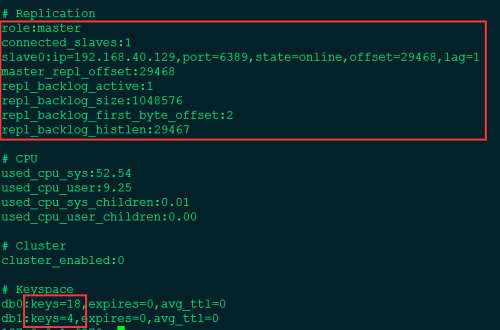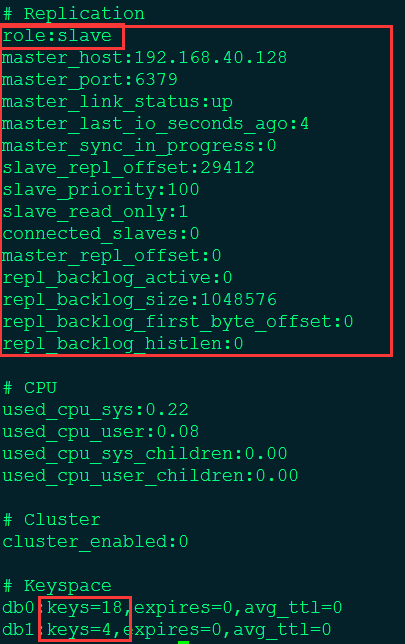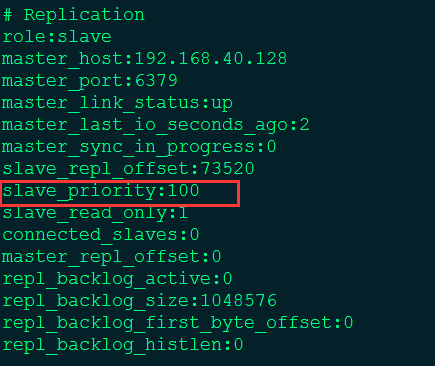案例测试:
1. Master新增网卡,修改server端配置
IP : 192.168.40.128/24
注释: bind,支持网络连接
2. 新建虚机slave,配置网络,修改redis配置
#slaveof <masterip> <masterport>
slaveof 192.168.40.128 6379
# masterauth <master-password>
masterauth "zcy1991"
3. 启动redis,打开日志


4. 查看Replication信息
Master:


Slave:


5.配置文件 “主从复制”部分 【翻译+理解】 (Verion 3.2.8)
################################# REPLICATION (复制) #################################
-------------------------------------------
# Master-Slave replication. Use slaveof to make a Redis instance a copy of
# another Redis server. A few things to understand ASAP about Redis replication.
#主从复制。 使用slaveof使一个Redis实例成为另一个Redis服务器的拷贝(副本)。
关于Redis复制的几个事情:
# 1) Redis replication is asynchronous, but you can configure a master to
# stop accepting writes if it appears to be not connected with at least
# a given number of slaves.
1) Redis复制是异步的,但是如果它看起来没有与至少给定数量的slave连接,您可以配置一个主设备停止接受写入。
# 2) Redis slaves are able to perform a partial resynchronization with the
# master if the replication link is lost for a relatively small amount of
# time. You may want to configure the replication backlog size (see the next
# sections of this file) with a sensible value depending on your needs.
2) 如果复制链路丢失相对较少的时间,Redis slave能够与master执行部分重新同步。 您可能需要根据需要,使用合理的值配置replication backlog 大小(请参阅此文件的下一个操作)。
# 3) Replication is automatic and does not need user intervention. After a
# network partition slaves automatically try to reconnect to masters
# and resynchronize with them.
# 3) 复制是自动的,不需要用户干预。 网络分割后,slaves 自动尝试重新连接到masters 并与它们重新同步。
# slaveof <masterip> <masterport>
# If the master is password protected (using the "requirepass" configuration
# directive below) it is possible to tell the slave to authenticate before
# starting the replication synchronization process, otherwise the master will
# refuse the slave request.
#如果master使用密码保护(使用下面的“requirepass”配置指令),可以在开始复制同步过程之前,告诉slaves进行认证,否则master将拒绝slave连接请求。
# masterauth <master-password>
-------------------------------------------
# When a slave loses its connection with the master, or when the replication
# is still in progress, the slave can act in two different ways:
#当一个slave与master断开连接或复制仍在进行时,slave可以采用两种不同的方式:
# 1) if slave-serve-stale-data is set to 'yes' (the default) the slave will
# still reply to client requests, possibly with out of date data, or the
# data set may just be empty if this is the first synchronization.
# 如果slave-serve-stale-data设置为“yes”(默认值),则slave仍将回复客户端请求,可能使用过期数据,或者如果这是第一次同步,则数据集可能为空。
# 2) if slave-serve-stale-data is set to 'no' the slave will reply with
# an error "SYNC with master in progress" to all the kind of commands
# but to INFO and SLAVEOF.
#如果slave-serve-stale-data设置为“no”,除了INFO和SLAVEOF,slave将回复错误“SYNC with master in progress”给所有类型的命令。
slave-serve-stale-data yes
# You can configure a slave instance to accept writes or not. Writing against
# a slave instance may be useful to store some ephemeral data (because data
# written on a slave will be easily deleted after resync with the master) but
# may also cause problems if clients are writing to it because of a
# misconfiguration.
# 您可以配置slave实例接受写入或不接受写入。 对slave实例进行写操作对存储一些临时数据可能是有用的(因为写在slave上的数据将在与master重新同步后很容易被删除),但是如果客户端因为错误配置而写入它,也会导致问题。
#
# Since Redis 2.6 by default slaves are read-only. 自2.6之后,slaves默认只读(不可写)
#
# Note: read only slaves are not designed to be exposed to untrusted clients
# on the internet. It's just a protection layer against misuse of the instance.
# Still a read only slave exports by default all the administrative commands
# such as CONFIG, DEBUG, and so forth. To a limited extent you can improve
# security of read only slaves using 'rename-command' to shadow all the
# administrative / dangerous commands.
# 注意:只读slaves并不设计为了暴露给互联网上的不受信任的客户端。 它只是一个防止滥用实例的保护层。 Slaves默认情况下仍然可以导出所有管理命令,如CONFIG,DEBUG等。 在有限的程度上,您可以使用“rename-command”来提高只读从设备的安全性,以隐藏所有管理/危险命令。
#作为从服务器,默认情况下是只读的(yes),可以修改成NO,用于写(不建议
slave-read-only yes
-------------------------------------------
# Replication SYNC strategy: disk or socket. 复制同步策略: disk或socket
#
# -------------------------------------------------------
# WARNING: DISKLESS REPLICATION IS EXPERIMENTAL CURRENTLY 警告:无磁盘的复制当前还处于试验阶段。
# -------------------------------------------------------
#
# New slaves and reconnecting slaves that are not able to continue the replication
# process just receiving differences, need to do what is called a "full
# synchronization". An RDB file is transmitted from the master to the slaves.
# The transmission can happen in two different ways:
#是否使用socket方式复制数据。目前redis复制提供两种方式,disk和socket。如果新的slave连上来或者重连的slave无法部分同步,就会执行全量同步,master会生成rdb文件。有2种方式:disk方式是master创建一个新的进程把rdb文件保存到磁盘,再把磁盘上的rdb文件传递给slave。socket是master创建一个新的进程,直接把rdb文件以socket的方式发给slave。disk方式的时候,当一个rdb保存的过程中,多个slave都能共享这个rdb文件。socket的方式就的一个个slave顺序复制。在磁盘速度缓慢,网速快的情况下推荐用socket方式。
#新的slaves和重新连接的slaves,不能继续复制过程只是接收差异,需要做的就是所谓的“完全同步”。 一个RDB文件从master传输到slaves。
# 传输可以以两种不同的方式发生:
# 1) Disk-backed: The Redis master creates a new process that writes the RDB
# file on disk. Later the file is transferred by the parent
# process to the slaves incrementally.
磁盘支持:Redis master创建一个新进程,负责将RDB文件写入磁盘。 稍后,该文件由父进程以增量方式传送到slaves。
# 2) Diskless: The Redis master creates a new process that directly writes the
# RDB file to slave sockets, without touching the disk at all.
#无盘:Redis master创建一个新的进程,直接将RDB文件写入slaves sockets,而不触及磁盘。
# With disk-backed replication, while the RDB file is generated, more slaves
# can be queued and served with the RDB file as soon as the current child producing
# the RDB file finishes its work. With diskless replication instead once
# the transfer starts, new slaves arriving will be queued and a new transfer
# will start when the current one terminates.
#使用"磁盘支持"的复制,在生成RDB文件时,只要生成RDB文件,当前子进程就完成了它的工作,更多的slaves就可以排队并被提供这一份RDB文件。(可同时提供给多个slaves)
# 使用无盘复制,一旦传输开始,新slaves到达将排队,并且当当前的一个终止时,新的传输将开始。(顺序复制,一个接一个)
# When diskless replication is used, the master waits a configurable amount of
# time (in seconds) before starting the transfer in the hope that multiple slaves
# will arrive and the transfer can be parallelized.
#当使用“无盘复制”时,master在开始传输之前等待可配置的时间量(以秒为单位),希望多个slaves将到达并且传输可以并行化。
#
# With slow disks and fast (large bandwidth) networks, diskless replication
# works better. 使用慢磁盘和快速(大带宽)网络,无盘复制工作更好(建议socket)
repl-diskless-sync no
# When diskless replication is enabled, it is possible to configure the delay
# the server waits in order to spawn the child that transfers the RDB via socket
# to the slaves.
diskless复制的延迟时间,防止设置为0。一旦复制开始,节点不会再接收新slave的复制请求直到下一个rdb传输。所以最好等待一段时间,等更多的slave连上来。
#当启用无磁盘复制时,可以配置服务器等待的延迟,以便产生子进程,通过socket传输RDB给slaves。
# This is important since once the transfer starts, it is not possible to serve
# new slaves arriving, that will be queued for the next RDB transfer, so the server
# waits a delay in order to let more slaves arrive.
#这是很重要的,因为一旦传输开始,不可能服务新到达的slaves,它们将为下一个RDB传输排队,所以服务器等待一段时间,以便让更多的slaves到达。
-------------------------------------
# The delay is specified in seconds, and by default is 5 seconds. To disable
# it entirely just set it to 0 seconds and the transfer will start ASAP.
# 延迟以秒为单位指定,默认值为5秒。要完全禁用它,仅仅设置为0秒即可,传输将尽快开始。
repl-diskless-sync-delay 5
# Slaves send PINGs to server in a predefined interval. It's possible to change
# this interval with the repl_ping_slave_period option. The default value is 10
# seconds.
#slaves以预定义的时间间隔向服务器发送PING。可以使用repl_ping_slave_period选项更改此时间间隔。默认值为10秒。
#
# repl-ping-slave-period 10
-------------------------------------------
复制连接超时时间。master和slave都有超时时间的设置。master检测到slave上次发送的时间超过repl-timeout,即认为slave离线,清除该slave信息。slave检测到上次和master交互的时间超过repl-timeout,则认为master离线。需要注意的是repl-timeout需要设置一个比repl-ping-slave-period更大的值,不然会经常检测到超时。
# The following option sets the replication timeout for: 设置复制timeout
#
# 1) Bulk transfer I/O during SYNC, from the point of view of slave. 从slave角度看,批量传输I / O在SYNC期间。
# 2) Master timeout from the point of view of slaves (data, pings). 从slave角度看,master 超时(data,pings)
# 3) Slave timeout from the point of view of masters (REPLCONF ACK pings). 从masters角度看,slave超时(REPLCONF ACK pings)
#
# It is important to make sure that this value is greater than the value
# specified for repl-ping-slave-period otherwise a timeout will be detected
# every time there is low traffic between the master and the slave.
#重要的是确保此值大于为repl-ping-slave-period指定的值,否则每次master和slave之间的流量低时都会检测到超时。
#
# repl-timeout 60
-------------------------------------------
是否禁止复制tcp链接的tcp nodelay参数,可传递yes或者no。默认是no,即使用tcp nodelay。如果master设置了yes来禁止tcp nodelay设置,在把数据复制给slave的时候,会减少包的数量和更小的网络带宽。但是这也可能带来数据的延迟。默认我们推荐更小的延迟,但是在数据量传输很大的场景下,建议选择yes。
# Disable TCP_NODELAY on the slave socket after SYNC? SYNC之后在slave socket上禁用TCP_NODELAY?
#
# If you select "yes" Redis will use a smaller number of TCP packets and
# less bandwidth to send data to slaves. But this can add a delay for
# the data to appear on the slave side, up to 40 milliseconds with
# Linux kernels using a default configuration.
#如果选择“是”,Redis将使用较少数量的TCP数据包和较少带宽将数据发送到从站。但是这可能会增加数据出现在对端slave上的延迟,对于Linux内核,使用默认配置可以延迟40毫秒。
# If you select "no" the delay for data to appear on the slave side will
# be reduced but more bandwidth will be used for replication.
#如果选择“否”,数据在slave端出现的延迟将减少,但更多的带宽将用于复制
# By default we optimize for low latency, but in very high traffic conditions
# or when the master and slaves are many hops away, turning this to "yes" may
# be a good idea.
#默认情况下,我们针对低延迟进行优化,但在非常高的流量情况下,或者当master和slave相隔许多跳时,将其转换为“yes”可能是个好主意。
repl-disable-tcp-nodelay no
---------------------------------------
复制缓冲区大小,这是一个环形复制缓冲区,用来保存最新复制的命令。这样在slave离线的时候,不需要完全复制master的数据,如果可以执行部分同步,只需要把缓冲区的部分数据复制给slave,就能恢复正常复制状态。缓冲区的大小越大,slave离线的时间可以更长,复制缓冲区只有在有slave连接的时候才分配内存。没有slave的一段时间,内存会被释放出来,默认1m。
# Set the replication backlog size. The backlog is a buffer that accumulates
# slave data when slaves are disconnected for some time, so that when a slave
# wants to reconnect again, often a full resync is not needed, but a partial
# resync is enough, just passing the portion of data the slave missed while
# disconnected.
#设置复制backlog大小。backlog是一个缓冲器(buffer),当slave断开一段时间时积累slave数据,以便当slave想要再次重新连接时,通常不需要再“完全同步(full resync)”,而是“部分再同步(partial resync)”就足够了,仅仅传输slave在断开连接时错失的那部分数据(余下的)即可。
#
# The bigger the replication backlog, the longer the time the slave can be
# disconnected and later be able to perform a partial resynchronization.
#复制backlog越大,slave可以断开连接的时间就越长,之后就可以执行”部分重新同步(partial resynchronization)“。
# The backlog is only allocated once there is at least a slave connected. 只有在至少有一个slave连接时才分配backlog。
#
# repl-backlog-size 1mb
# After a master has no longer connected slaves for some time, the backlog
# will be freed. The following option configures the amount of seconds that
# need to elapse, starting from the time the last slave disconnected, for
# the backlog buffer to be freed.
# master没有slave一段时间会释放复制缓冲区的内存,repl-backlog-ttl用来设置该时间长度。单位为秒。
#在master已经不再连接slave一段时间后,backlog将被释放。 以下选项配置需要经过的秒数,从最后一个slave服务器断开的时间开始,backlog缓冲区被释放。
# A value of 0 means to never release the backlog. 值为0表示永不释放backlog
#
# repl-backlog-ttl 3600
---------------------------------
# 当master不可用,Sentinel会根据slave的优先级选举一个master。最低的优先级的slave,当选master。而配置成0,永远不会被选举。
# The slave priority is an integer number published by Redis in the INFO output.
# It is used by Redis Sentinel in order to select a slave to promote into a
# master if the master is no longer working correctly.
#slave优先级是由Redis在INFO输出中发布的整数。 它由Redis Sentinel使用,以便选择slave,如果master不再正常工作,则升级为主设备。
# A slave with a low priority number is considered better for promotion, so
# for instance if there are three slaves with priority 10, 100, 25 Sentinel will
# pick the one with priority 10, that is the lowest.
#具有低优先级编号的slave被认为更好地用于提升,因此例如如果存在具有优先级10,100,25的三个从设备,则哨兵将选择具有优先级10,即最低的那个。
# However a special priority of 0 marks the slave as not able to perform the
# role of master, so a slave with priority of 0 will never be selected by
# Redis Sentinel for promotion.
#然而,0的特殊优先级标志着slave不能执行主设备的角色,因此优先级为0的从设备将不会被Redis Sentinel选择用于升级。
# By default the priority is 100.
slave-priority 100

-----------------------------------------
#
# It is possible for a master to stop accepting writes if there are less than
# N slaves connected, having a lag less or equal than M seconds.
#如果连接少于N个slave,具有小于或等于M秒的滞后,则master可以停止接受写入。
# The N slaves need to be in "online" state.
#
# The lag in seconds, that must be <= the specified value, is calculated from
# the last ping received from the slave, that is usually sent every second.
#以秒为单位的滞后,必须小于指定值,根据从slave接收的最后一次ping计算,通常每秒发送一次。
# This option does not GUARANTEE that N replicas will accept the write, but
# will limit the window of exposure for lost writes in case not enough slaves
# are available, to the specified number of seconds.
#此选项不保证N个副本将接受写入,但会在没有足够的slave可用的情况下,将丢失写入的曝光窗口限制为指定的秒数。
# For example to require at least 3 slaves with a lag <= 10 seconds use: 例如,至少需要3个slave,lag小于10s
#
#redis提供了可以让master停止写入的方式,如果配置了min-slaves-to-write,健康的slave的个数小于N,mater就禁止写入。master最少得有多少个健康的slave存活才能执行写命令。这个配置虽然不能保证N个slave都一定能接收到master的写操作,但是能避免没有足够健康的slave的时候,master不能写入来避免数据丢失。设置为0是关闭该功能。
# min-slaves-to-write 3
# 延迟小于min-slaves-max-lag秒的slave才认为是健康的slave
# min-slaves-max-lag 10
#设置1或另一个设置为0禁用这个特性。
# Setting one or the other to 0 disables the feature.
#
# By default min-slaves-to-write is set to 0 (feature disabled) and
# min-slaves-max-lag is set to 10. 默认配置
# A Redis master is able to list the address and port of the attached
# slaves in different ways. For example the "INFO replication" section
# offers this information, which is used, among other tools, by
# Redis Sentinel in order to discover slave instances.
# Another place where this info is available is in the output of the
# "ROLE" command of a masteer.
# Redis master能够以不同的方式列出所连接slave的地址和端口。 例如,“INFO replication”部分提供此信息,除了其他工具之外,Redis Sentinel还使用该信息来发现slave实例。 此信息可用的另一个地方在masterser的“ROLE”命令的输出中。
#
# The listed IP and address normally reported by a slave is obtained
# in the following way:
#通常由slave报告的列出的IP和地址,通过以下方式获得:
# IP: The address is auto detected by checking the peer address
# of the socket used by the slave to connect with the master.
#IP:通过检查slave与master连接使用的套接字的对等体地址自动检测地址。
# Port: The port is communicated by the slave during the replication
# handshake, and is normally the port that the slave is using to
# list for connections.
#端口:端口在复制握手期间由slavet通信,并且通常是slave正在使用列出连接的端口。
# However when port forwarding or Network Address Translation (NAT) is
# used, the slave may be actually reachable via different IP and port
# pairs. The following two options can be used by a slave in order to
# report to its master a specific set of IP and port, so that both INFO
# and ROLE will report those values.
#然而,当使用端口转发或网络地址转换(NAT)时,slave实际上可以通过(不同的IP和端口对)来到达。 slave可以使用以下两个选项,以便向master报告一组特定的IP和端口,以便INFO和ROLE将报告这些值。
# There is no need to use both the options if you need to override just
# the port or the IP address. 如果你需要仅覆盖端口或IP地址,则没必要使用这两个选项。
#
# slave-announce-ip 5.5.5.5
# slave-announce-port 1234
参考资源:
1.redis3.0配置文件详解
转载于:https://blog.51cto.com/zcyns/1903276
![[原]TCP/UDP使用细节备忘](http://pic.xiahunao.cn/[原]TCP/UDP使用细节备忘)




)







中)





